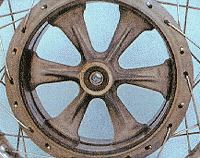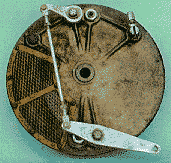
The following is taken from an article entitled, "ITALIAN COMPETITION BRAKES" written by GIANNI PERRONE. I wish to give the author full credit for his wonderful work, and am only reprinting this material to make it accessible to more motorcycle enthusiasts.

The hub of the Fontana 250-mm brake had a central "crown" with large air passages.
The first creation of Daniele Fontana, who was known to his friends as Tito Gobbi because of a vague resemblance to the famous opera singer, was the coupling of two Oldani brakes which was fitted to a 350 Bianchi racer; later he developed a double-camplate hub which for its time was the best racing brake around. It was the envy of the competition, MV and Gilera, whose riders complained that the Bianchi was unbeatable in braking (due also to the light weight of the twin-cylinder bike and especially to the skill of Remo Venturi).
In 1964, just before Bianchi closed its factory, Fontana decided to begin manufacturing its brakes and then selling them not only to private bikers but also to other companies. Soon its range came to include three excellent front brakes, remained justly famous, entirely made of magnesium alloy (with cast-iron rings containing the braking "strip", cast-in) and equipped with four shoes.

External view of the shoe plate for the Fontana 250 mm brake, complete with protective guard for the air intake and linkage with threaded adjusters.
The "large" Fontana (effective diameter 250 mm) is used on the official Triumph and BSA three-cylinders of the 750 formula and Percy Tait's two-cylinder Grand Prix 500, as well as those of the Keolliker team.
The "midsize" (called "230") had an effective diameter of 210 mm and was designed for racing and sports bikes with engine displacement of 250-350 cc. It weighed 5 kg and in 1965 cost 65,000 liras.

Internal view of the same shoe plate of the previous photo. Each of the two cams actuates a shoe.
The "small" Fontana was used on the other hand for smaller racers like the Motobi 175, Morbidelli 125 and similar bikes. For Aermacchi Ala d'Oro 125 a slightly different version (170 mm) was manufactured, which equipped also many 50 cc racers.
Fontana continued to produce brakes even after the advent of disc-brakes; his brakes were always distinguished from the opposition by their lightness. Unfortunately, his premature death put an end to his activity, which would have provided other products of as high quality as his brakes always were.
![]()